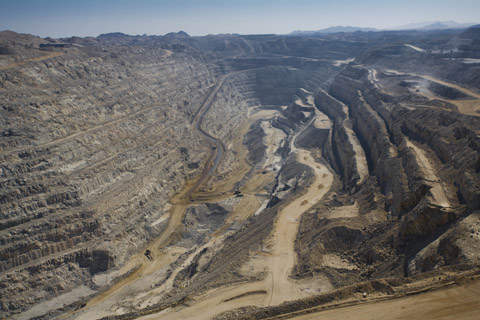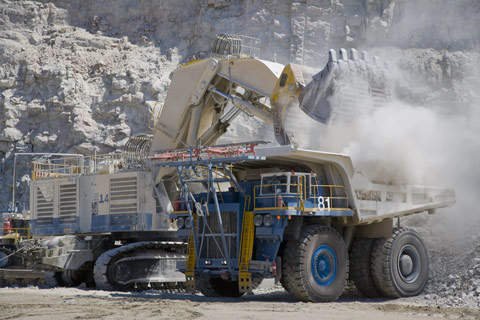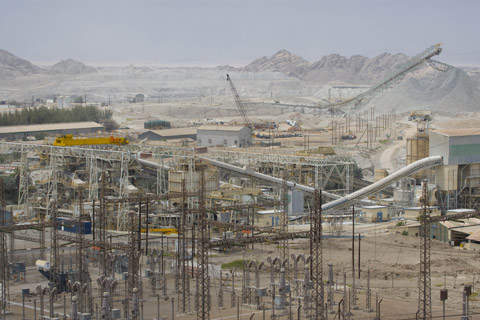The Rossing Uranium mine is located 70km north-east of Swakopmund in Namibia, Africa. It is the fifth largest producer of uranium in the world and accounts for about 8% of the world’s uranium oxide production. The licence area of the mine is 180km2 of which 20km2 are used for mining, waste disposal and processing.
Captain Peter Louw discovered the mine in the 1920s. In the 1960s, Rio Tinto (then RTZ Corporation) carried out the geophysical and geological surveys, drilling and evaluation of the mine. Discovered to be a low-grade ore body, the mine started operations in 1976 and was on full-scale uranium oxide production at an average of 4,500t/yr in 1979.
The mine is the property of Rossing Uranium, a subsidiary of Rio Tinto. Rio Tinto directly holds a 69% stake in Rossing Uranium with the other stakeholders being Iranian Foreign Investment (15%), IDC of South Africa (10%), the Government of Namibia (3%) and 13 local individual shareholders (3%).
An exploration drilling programme was conducted in 2008 to understand the SK ore body of the mine (adjacent to the SJ ore body). With such activities the focus moves towards production requiring more drilling and less exploration.
One of the 12 leach tanks at the Rossing processing plant failed in December 2013 causing spillage, which forced Rio Tinto to shut down the tank. Production from the tank was resumed in January 2014. The failure was caused by localised external corrosion in the tank and a thorough investigation into all tanks revealed a number of issues that have called for full restoration.
Public concerns
Concerns were raised over the possible seepage from the uranium mine’s tailings polluting the nearby Swakop River. Mining workers who have been associated for a long term at the mine also have reported of lung infection, cancer and certain unexplained illnesses associated with work, revealed a study report in April 2014. The study was conducted on the mine’s existing and former workers.
A similar report based on a study conducted by Namibia’s Labour Resource and Research Institute also raised concerns over the health of workers at the mine.
Geology and Reserves
The ore body of the Rossing Uranium mine is the largest granite-hosted uranium deposit in Namibia. About 1,000 years ago, a sea covered the Namib Desert, under which formed sedimentary rocks. These rocks were exposed to extremely high temperatures and sunk deep into the earth. This resulted in the formation of sediments causing the molten granite to be embedded in the sedimentary rock. This granite Alaskite rock consists of uranium bearing minerals in two forms – the microscopic crystals of uraninite or visible crystals of betauranophane.
The mine has total reserves of 27mt at 3.9ct/t from four ore bodies including A154S, A154N, A418 and A21.
Open pit mining
The Rossing Uranium mine is a low grade Alaskite open pit mine (SJ pit) which is 3.5km long and 345m deep. Conventional methods including drilling, blasting, loading and hauling are used for mining uranium from the open pit. A total of 33.9 million tonnes of rock was mined in 2008.
In 2008, 70 people were employed, taking staff capacity of the mine operations department to 460. The staff were trained on three retired 730E trucks. The haul truck fleet was fitted with three-point safety belts and re-routing hydraulic pipes to reduce the risk of fire.
In the same year, new earth moving equipment was added including ten 730E Komatsu haul trucks, two pit viper drills, one PC5500 diesel shovel, two 777 water trucks and a diesel-powered motivator.
Two Marion 201M rope shovels, a P&H 2100 rope shovel and a Demag H485 hydraulic excavator are the current loading equipments used. A fleet of 11 180t Haulpak trucks take up haulage process.
Processing
The activities of ore processing include extraction of uranium from the mined rock, production of uranium oxide, and secure packing and shipment of the processed uranium.
The mined ore is delivered to primary crushers by haul trucks and then by conveyor to the coarse ore stockpile. The process continues until the particles become smaller than 19mm. Wet grinding, using four rod mills with a diameter of 4.3m, are used to crush the ore to the level of mud.
This is followed by leaching and oxidation during which the pulped ore is oxidised with ferric sulphate and dissolved in sulphuric acid. The pulp, containing suspended sand and slime, is separated after washing. It is then transported to the tailings disposal area.
The slimes are washed by counter-current decantation thickeners delivering a clear uranium-bearing solution. This pregnant solution under the continuous ion exchange, gets in contact with beads with formulated resin and uranium ions are absorbed from the solution. The resulting eluate is a purified and concentrated uranium solution. The next process is the solvent extraction that occurs in two stages, the eluate is mixed with an organic solvent that takes the uranium-bearing component and then is mixed with ammonium sulphate solution.
This is followed by precipation which creates yellow slurry, filtration which creates yellow cake, and drying and roasting of the uranium oxide which is packed into metal drums. These drums of uranium oxide are then loaded and exported to overseas converters for further processing.
Production
In 2008, Rossing Uranium Mine produced 4,108t of uranium oxide, compared to 3,046t in 2007. This production was the highest in the last 20 years and in excess of 4,004t set as target for 2008. In September 2008, the mine achieved the highest daily production of 23.2t against the daily target of 11t. The production in 2012 stood at 2,699t and dipped by about 11% (Rio Tinto’s share) in 2013.
Environment
The business activities of the mine have an adverse impact on the environment. Rossing Uranium is continuously evaluating options to improve specific areas and reduce such environmental impact.
In 2008, the mine used energy of 14.09mj/t of ore processed higher than the annual target of 117mj/t of ore processed. The carbon emissions per unit of production were lower than the previous year. It has also consumed 3.7 million cubic meters of water higher than the target of 3.5 million cubic meters. The key focus of the mine will be to reduce carbon emissions by installing improved systems and technologies and implementing water saving projects.
Future Developments
The primary focus of the Rossing Uranium Mine is to improve safety performance by achieving zero lost-time injuries and medical cases. It seeks to develop its mining area to reach the target of 45mt to 68mt of mining rock.
Eventually, outdated machinery and electrical systems will be upgraded in the processing plants to meet its nameplate production capacity. All this has to be achieved with the limited funds available.
Several upgrades have been taken up on the equipment installed at the mine, to extend the mine’s life to 2021. Plans are also in place to extend the mine life further to 2026 by undertaking a number of expansions.






